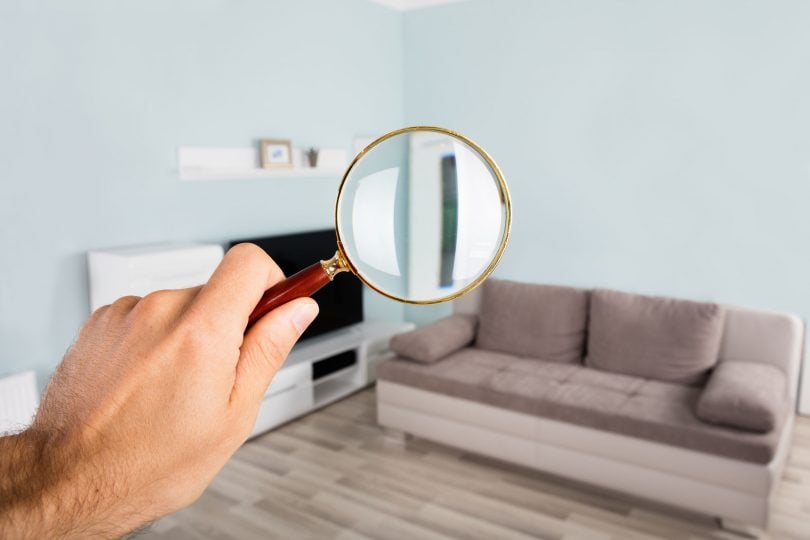You know what’s just about the worst? Moving into your new home and only then discovering a leak in the basement, or old piping that needs replacing, or an issue with the roof. So to be sure you’re 100% clear on what you’ll get with that title, here is a visual checklist of all of the things you should inspect before you move forward with buying your new home. Many of these things aren’t covered by a home inspector, particularly cosmetic details. So it’s time to do your homework on the walk-through.
Heating and Cooling Systems
Depending on what season it is, it may not be obvious how the heating and cooling systems are functioning. Are they loud? Do they emit a strange smell? One at a time, use the thermostat to check the functioning of both. If you turn down the temperature, does the cooling system turn on properly? Check that all rooms in the house receive proper air flow. Then do the same with the heat. Make sure that both also shut off after an appropriate reading on the thermostat.
Electrical
Check the lighting. Does everything work properly? Are any lights functioning poorly? Check every electrical outlet by plugging in a radio or a light to each one. Take a look at the circuit board, too — it may be functioning enough to pass inspection, but does it look reliable? Lastly, the previous owners may be aware of certain fuses that blow regularly. This isn’t a good sign, but it probably wasn’t on their moving out checklist to fix that wiring.
Plumbing
Start by inspecting each sink for drips or leaks underneath the sink bowl while in the “off” position, and then in the “on” position. Check the drains for odd smells and for proper drainage by letting the water run for a few minutes to see if the drain backs up, or if the flow of water creates any leaks beneath the sink bowl. Then check the toilets. Do they flush properly and refill without leaking into the bowl? Make sure the inner workings of the toilet are working properly and listen for any sounds of leaking water. In the basement, look for any water on the floor near pipe elbows or joints.
Kitchen
Check the counters for any significant dings, scratches, or signs of rot if they are wooden. Inspect the cabinets for a smooth finish, and open each one to check that the hinges and hardware work properly. Open every drawer to check that the tracks function smoothly and hardware is well-attached. Turn on every appliance, including the dishwasher, to be sure they all function properly. Take a close look at the floor to see if there is any damage from oil or food residue, as the kitchen, entryway, and the bathroom are most likely to see water damage.
Bathroom
Check the bathroom fixtures like tub, toilet, and sink for chips or cracks. Sit on the toilet (while it’s closed!) to see if it is securely fastened to the floor or has any wobble — wobble can mean leaks down the road. Check if the ventilation fan works, and turn on both the bath and shower functions if applicable to make sure one the tub doesn’t drip while the shower is on.
Bedrooms and Main Rooms
Check the doors to be sure each one opens and closes properly, and the locks both lock and unlock smoothly and easily. For exterior doors, check that the threshold fully meets the bottom of the door without leaving any gaps. For rooms with carpets, look for any obvious stains that may have permeated through to the carpet pad beneath as well as any obvious wear-and-tear that is unappealing. Sun fading can also be an issue, so move the furniture around if there are any present during the showing.
Windows
Check for drafts around the edges of the windows by holding your hand along its periphery to check for air flow. Open each window to be sure it functions properly and hasn’t been painted shut. Look for cloudy window glass, scratches or cracks, or loose glass that is missing caulking.
Walls
Run your hand over the finish on each wall to check for a smooth paint job, or paint that may be concealing wallpaper. Look for holes or visible seams in the drywall, cracks in wall tiles, or missing edging or grout.
Attic or Crawlspace
Check for cleanliness to ensure no animals have taken up residence. Look for mesh or wire coverings on all ventilation holes, and manually turn on vent fans to be sure they are working properly. Check visible insulation for gaps or holes.
Decks, Porches, and Outdoor Stairways
First and foremost, look for stability. Check the joints where the porch/deck is attached to the building, as well as the foundation underneath supporting beams. Then check for the condition of the wood, railings, and stairs if applicable. Make sure stairs are firmly attached and there are no exposed screws or nails.
What else should you be considering as you prepare to move? Check out our complete moving checklist to make sure you’ve covered all your bases. Then hire a top-notch professional moving service to help your move go quickly and smoothly!








